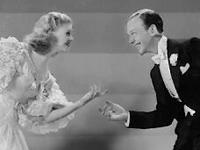Hard Times

BROOKE GLADSTONE: In Woody Allen’s film The Purple Rose of Cairo, a young woman in Depression-era New York City escapes from her dreary life into a world of glamour and romance and money on the movie screen, that is, until the movie’s male hero walks off the big screen and into her little life.
[CLIP]:
MIA FARROW AS CECILIA: I'm confused. I’m married. I, I just met a wonderful new man. He’s fiction, you know, but you can't have everything.
[END CLIP]
[SOUNDTRACK UP AND UNDER]
BROOKE GLADSTONE: In his new cultural history of the Great Depression, Dancing in the Dark, Morris Dickstein examines artifacts of the era, ranging from the social realist novels to the Busby Berkeley musicals. I wondered what he thought of Purple Rose of Cairo.
MORRIS DICKSTEIN: I love the movie, but it’s really based on the cliché that people went to the movies simply to escape their problems. And if you look at the movies themselves – and they went to very silly movies – but if you look at the movies that we still look at, they're, they’re anything but silly. They're very marked by people’s problems and concerns. And so, you know, I take that really as the stereotype of Depression culture pretty much against which I've written this book.
BROOKE GLADSTONE: In other words, he says, when we peer back through time, what looks like escape really is exploration.
MORRIS DICKSTEIN: What people call the escapist stories, such as Busby Berkeley, I find full of references to the Depression. I like to say that the only difference is that some of the references to the Depression are simply more oblique than others. They're very direct in Busby Berkeley, much more oblique, for example, in the Fred Astaire/Ginger Rogers movies or in the screwball comedies, but I don't think they can be understood, except as artifacts of the Depression.
BROOKE GLADSTONE: And when you say direct, you mean that the Busby Berkeley musicals depicted struggling showgirls.
MORRIS DICKSTEIN: Well yeah, the showgirl was one of the main figures of Depression in the sense that she was often out of work or subject to the vagaries of the market. One of the best of these stories, The Gold Diggers of 1933, starts with rehearsing a show that’s called We're in the Money.
[CLIP]:
GINGER ROGERS AND CHORUS SINGING: We're in the money, we're in the money We've got a lot of what it takes to get along.
[END CLIP]
[SOUNDTRACK UP AND UNDER]
MORRIS DICKSTEIN: You see these surreal showgirls wearing large coins that barely cover their bodies, and in comes the sheriff to interrupt the number and close the show. So, it couldn't be more explicit than that, except, of course, later on it is more explicit than that.
[BROOKE LAUGHS] And you have the concluding number, called Remember My Forgotten Man, and that’s the figure that Roosevelt had first mentioned in a 1932 campaign speech and got associated with the veterans of World War I who are now being neglected and who just earlier had been camped out in Washington, trying to get early payment of their bonuses. So, this is a very direct contemporary reference.
BROOKE GLADSTONE: There’s another one in the fabulous, screwball comedy, My Man Godfrey. The idle rich go out in search of a bunch of items, one of which is supposed to be a forgotten man. And the wealthy but adorable Carole Lombard finds William Powell.
[CLIP]:
WILLIAM POWELL AS GODFREY: Do you mind telling me just what a scavenger hunt is?
CAROLE LOMBARD AS IRENE BULLOCK: Well, a scavenger hunt is exactly like a treasure hunt, except in a treasure hunt you try to find something you want and in a scavenger hunt you try to find something that nobody wants.
WILLIAM POWELL AS GODFREY: Mm, like a forgotten man.
CAROLE LOMBARD AS IRENE BULLOCK: That’s right, and the one that wins gets a prize, only there really isn’t a prize. It’s just the honor of winning, because all the money goes to charity, that is, if there’s any money left over, but then there never is.
WILLIAM POWELL AS GODFREY: Mm.
[END CLIP]
MORRIS DICKSTEIN: And William Powell, of course, turns out to be a hobo living in a Hooverville encampment on the shores of the East River, which was pretty much a slum at the time. But, of course, he turns out to be originally a Boston Brahmin who nearly committed suicide but stopped just short of the river and ended up being a forgotten man. And he, in a sense, rescues this daffy rich family from its own waywardness, even rescues their financial investments. And --
BROOKE GLADSTONE: And transforms the Hooverville, as well.
MORRIS DICKSTEIN: Right, and transforms it into a nightclub called The Dump.
[BROOKE LAUGHS] Very enterprising, and you might say there’s a real belief in free enterprise there, rather than government programs.
BROOKE GLADSTONE: Let's talk about the most iconic duo of the period. I mentioned in the intro, Astaire and Rogers. This is always regarded as the quintessence of escapist fare, but you suggest that it really wasn't that, at all.
MORRIS DICKSTEIN: Well, here you have two people. They don't know what everyone else knows, that they're made for each other. And they're so perfect, and yet, of course, they can't agree on a single thing. They misunderstand everything the other one does. And then at certain moments, suddenly they're in tune with each other, and it’s not when they're speaking but it’s only when they're dancing, and when they're dancing they're suddenly sublimely together. And this turns out to be an emblem of Depression culture, as a whole. It’s all about separately we fail, but together we may actually be able to face the music.
[CLIP/MUSIC UP AND UNDER]:
FRED ASTAIRE SINGING: There may be trouble ahead. But while there’s moonlight and music and love and romance, let’s face the music and dance.
[END CLIP]
[SOUNDTRACK CONTINUES UP AND UNDER]
MORRIS DICKSTEIN: So, I find a lot of the culture to be very parallel to the New Deal, ‘cause the New Deal was giving exactly the same message. No one had ever believed that federal government was really that responsible for the American people’s welfare, and suddenly Roosevelt convinced them that we had to all pull together. And so I like to say that besides the New Deal, the arts were the other big stimulus package of the Great Depression.
BROOKE GLADSTONE: Let's drill into the dance a little bit more. You have the dance of the showgirls in the Busby Berkeley musicals, and then you have this dance of Fred Astaire and Ginger Rogers, which, though very carefully choreographed, has a certain almost improvisational quality in the way that it’s performed. Was there something about the way that Astaire and Rogers danced that made it different from other dance?
MORRIS DICKSTEIN: Well, one thing is, of course, that in many European countries the Depression took the form of social unrest and seeking extreme solutions -- fascism, Communism and so on. In America, it took this form of stagnation and also of self-blame and stasis. Even people who were moving around, people taking to the road, were lamely moving from place to place, with really no hope of finding anything better at the other end. One beautiful emblem of that is the vogue of marathon dancing, where people ‘round, going round and round and round, going absolutely nowhere. And this is why I think energy and movement became one of the main themes of Depression culture.
[MUSIC UP AND UNDER] There was a tremendous push to get the country moving again, and FDR and Warner Brothers were really on the same page. Now, in Astaire you have something in addition to that that’s very, very special and very important to Depression culture, and that is this extraordinary elegance, this extraordinary grace of movement that had to be supplying something that was a psychological boost, a boost of morale –
[SOUND OF TAP DANCING/MUSIC] - that I think gradually turned the Depression from really despair to hopefulness in a way that becomes very marked later in the decade.
BROOKE GLADSTONE: So we've talked about how the films that we might dismiss as purely escapist artifacts were much, much more. You make the same argument about the gangster film.
MORRIS DICKSTEIN: Well, in the first part of my book I deal with people who are really down and out, I mean, really tremendous poverty and depravation, despair. In the second part of the book I deal more with middle class problems, which largely were a concern with failure, a fear of falling. You know, as FDR said, “The only thing have to fear is fear itself.” And that concern got translated into a fascination with parables of success and failure, of sudden changes in fate and fortune. And there you have the showgirl story of the girl stepping out of the chorus and suddenly becoming a star, but you also have the gangster ruthlessly working his way up from the gutter and ending up, in the end, in the gutter again, but in a way that represented a very complex form of identification on the, on the part of the audience.
[CLIP]:
ACTOR: I wonder what to do with so much dough.
ACTOR: Ah, you had started.
ACTOR: I'll make big shots out of you yet.
ACTOR: Anything you say goes to me, Putty.
ACTOR: Me too.
ACTOR: And here’s to us.
[END CLIP]
MORRIS DICKSTEIN: On the one hand, it’s charged with energy. The way Edward G. Robinson or Jimmy Cagney in The Public Enemy played it is just crackling with energy. But it’s also, it’s in a way a remnant, a reference to the old self-help mentality. This is the way we can still do it in a world in which business is not really functioning. We do it as gangsters. We do it in the old 1920’s Al Capone mode.
[CLIP]:
ACTOR: When Dutch comes around he’s going to leave you some beer, and you’re going to drink it, and you’re going to kick him with the dough. If you don't, somebody’s going to drop by here and kick your teeth out one at a time. Get me?
ACTOR: Yeah, and you'll be needin’ some right away. How many should we leave?
ACTOR: Oh -- two, two kegs.
ACTOR: You hear that, Dutch? Bring in five kegs.
[END CLIP]
MORRIS DICKSTEIN: Beginning very early in the '30s, studios like Warner Bros. had to put disclaimers at the beginnings of movies like The Public Enemy saying this is only a documentary about a problem of our society; this is not something that anyone would want to identify with. But, of course, those disclaimers are meaningless because it’s the energy of the performance that really carries you.
BROOKE GLADSTONE: So, The New York Times a few weeks ago had a piece about how the recession was creeping into the fall crop of TV shows, not necessarily in a literal way. You'd have somebody suffering the economic downturn of the '80s or have somebody who lost a job for reasons other than the current recession. Was this technique of swapping out the present for an analogous era also deployed in the '30s?
MORRIS DICKSTEIN: Yes, very often these things were done in historical novels. I mean, Gone with the Wind is certainly a Depression movie. It’s about living through the after effects of catastrophe, about a strong woman trying to hold things together. In that respect it’s even like Grapes of Wrath. I interpret even The Wizard of Oz as a kind of road story, in which you have a catastrophic situation. The beginning and the end of the movie are in black and white, and you see very much a Depression-era Kansas. Then you take to the road.
[SOUNDTRACK UP AND UNDER]
DOROTHY AND MUNCHKINS SINGING: You’re off to see the Wizard, the wonderful Wizard of Oz!
MORRIS DICKSTEIN: Judy Garland rescues first the proletariat of Oz, the Munchkins, and then she joins up with other characters in that kind of solidarity. They're looking for just those qualities that were needed during the Depression. They're looking for heart, for mind, for courage. And they take the Yellow Brick Road.
MUNCHKINS AND DOROTHY SINGING: We're off to see the Wizard, the wonderful Wizard of Oz!
BROOKE GLADSTONE: Then she goes to Oz and meets up with this big fraud who’s the Wizard. Am I seeing some sort of political dialectic here that I oughtn’t?
MORRIS DICKSTEIN: Well, you’re seeing something that’s certainly politically ambiguous, because I'm not the first one to compare the Wizard of Oz to FDR. And there were a lot of figures in 30’s movies that looked a little like FDR. On the other hand, the message could even be seen as a Republican message. It’s not government help, it’s not the Wizard’s help that you need; it’s self help. And so, there’s a wonderful political ambiguity there.
BROOKE GLADSTONE: Self help and ruby slippers.
MORRIS DICKSTEIN: Right.
[BROOKE LAUGHS] Right, right.
BROOKE GLADSTONE: So as you stare down this telescope, into an era so many decades ago, where do you see the greatest contrast?
MORRIS DICKSTEIN: Well, the fact that people were doing things to a remarkable extent together. In other words, they went to the movies together, they went to movies as a habit. They all saw the same movies each week. When FDR went on for one of his fireside chats, everyone listened to it. It was the one thing that was available. There was nothing competing with it. That may be somewhat true today when Obama gives an address to a joint session of Congress, but I think, I think largely now we have hundreds of cultural choices today.
BROOKE GLADSTONE: So we won't have the pop culture to pull us all together.
MORRIS DICKSTEIN: There'll always be crazes. There'll be a Dan Brown craze, there'll be a craze for an American Idol, and so on. People in many ways like to do things that other people are doing, and they like to talk about it with them. This is why, one of the reasons that sports is the lingua franca of conversation in many parts of the country.
BROOKE GLADSTONE: But we won't be able to rely on the pop culture to unify us during this time, to make us feel less afraid and less alone.
MORRIS DICKSTEIN: I don't think so. The culture, I think, is fragmenting in too many different directions.
[MUSIC UP AND UNDER]
BROOKE GLADSTONE: Morris Dickstein is a professor of English and theater at the City University of New York and author of Dancing in the Dark: A Cultural History of the Great Depression. Thank you very much.
MORRIS DICKSTEIN: It’s been a pleasure.
[MUSIC/MUSIC UP AND UNDER]
BOB GARFIELD: That's it for this week's show. On the Media was produced by Jamie York, Mike Vuolo, Mark Phillips, Nazanin Rafsanjani, Michael Bernstein and P.J. Vogt, with more help from James Hawver and Dan Mauzy, and edited – by Brooke. We had technical direction from Jennifer Munson and more engineering help from Zach Marsh.
BROOKE GLADSTONE: Katya Rogers is our senior producer and John Keefe our executive producer. Bassist/composer Ben Allison wrote our theme. You can listen to the program and find free transcripts at Onthemedia.org. You can also post comments there, or email us at onthemedia@wnyc.org. This is On the Media from WNYC. I'm Brooke Gladstone.
BOB GARFIELD: And, I'm Bob Garfield.

